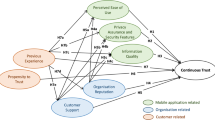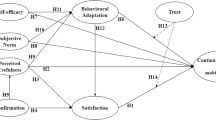Abstract
In the current context of ubiquitous connectedness through portable mobile devices and services, it is important to comprehend more fully the nature of consumer/bank interactions and relationships. At the same time, firms in the service sector are trying to provide customers with impactful positive experiences. This article examines the impact of mobile banking experience on trust and commitment based on the customer experience dimensions defined by Schmitt and expanded to include the negative aspect of the affective dimension. A total of 396 panellists of a recognized Canadian research firm responded to a self-administered online questionnaire. Findings demonstrate that the cognitive and negative affective dimensions of mobile experience impact trust, whereas the positive affective/sensory dimension influences commitment. The behavioural and social dimensions do not have significant impacts. This study enriches the theoretical corpus of knowledge in customer experience, relationship marketing and m-banking literature, lending practical implications for mobile services managers. Financial institutions, for example, should offer sensory mobile applications designed to appeal to the eye or to the touch (positive affective/sensory dimension), provide tools and information intended to arouse user curiosity and provoke reflection (cognitive dimension), while avoiding negative experiences which can lead to damaging feelings/emotions such as disappointment and anger (negative affective dimension).


Similar content being viewed by others
References
Agariya, A.K., and D. Singh. 2011. What really defines relationship marketing? A review of definitions and general and sector-specific defining constructs. Journal of Relationship Marketing 10 (4): 203–237.
Alavi, S., and V. Ahuja. 2016. An empirical segmentation of users of mobile banking apps. Journal of Internet Commerce 15 (4): 390–407.
Alalwan, A.A., Y.K. Dwivedi, N.P. Rana, and R. Algharabat. 2018. Examining factors influencing Jordanian customers’ intentions and adoption of internet banking: extending UTAUT2 with risk. Journal of Retailing and Consumer Services 40: 125–138.
Allen, J.N., and P.J. Meyer. 1990. The measurement and antecedents of affective, continuance and normative commitment to the organization. Journal of Occupational Psychology 63 (1): 1–18.
Athanasopoulou, P. 2009. Relationship quality: A critical literature review and research agenda. European Journal of Marketing 43 (5/6): 583–610.
Babin, B.J., and J.S. Attaway. 2000. Atmospheric affect as a tool for creating value and gaining share of customer. Journal of Business Research 49: 91–99.
Balaji, M.S., S.K. Roy, and A. Quazi. 2017. Customers’ emotion regulation strategies in service failure encounters. European Journal of Marketing 51 (5/6): 960–982.
Barnes, S.J., and B. Corbitt. 2003. Mobile banking: Concept and potential. International Journal of Mobile Communications 1 (3): 273–288.
Bart, Y., V. Shankar, F. Sultan, and G.L. Urban. 2005. Are the drivers and role of online trust the same for all web sites and consumers? A large-scale exploratory empirical study. Journal of Marketing 69 (4): 133–152.
Bauer, H.H., M. Grether, and M. Leach. 2002. Building customer relations over the Internet. Industrial Marketing Management 3 (2): 155–163.
Berraies, S., K. Ben Yahia, and M. Hannachi. 2017. Identifying the effects of perceived values of mobile banking applications on customers: Comparative study between baby boomers, generation X and generation Y. International Journal of Bank Marketing 35 (6): 1018–1038.
Bhattacherjee, A. 2002. Individual trust in online firms: Scale development and initial test. Journal of Management Information Systems 19 (1): 211–241.
Brakus, J.J., B.H. Schmitt, and L. Zarantonello. 2009. Brand experience: What is it? How is it measured? Does it affect loyalty? Journal of Marketing 73 (3): 52–68.
Brun, I., L. Rajaobelina, L. Ricard, and B. Berthiaume. 2017. Impact of customer experience on loyalty: A multichannel examination. The Service Industries Journal 37 (5–6): 317–340.
Chaouali, W., N. Souiden, and R. Ladhari. 2017. Explaining adoption of mobile banking with the theory of trying, general self-confidence, and cynicism. Journal of Retailing and Consumer Services 35: 57–67.
Chaouali, W., I. Ben Yahia, and N. Souiden. 2016. The interplay of counter-conformity motivation, social influence, and trust in customers’ intention to adopt Internet banking services: The case of an emerging country. Journal of Retailing and Consumer Services 28: 209–218.
Chen, Y.-M., T.-H. Hsu, and Y.-J. Lu. 2018. Impact of flow on mobile shopping intention. Journal of Retailing and Consumer Services 41: 281–287.
Chouk, I., and J. Perrien. 2005. La confiance du consommateur vis-à-vis d’un marchand Internet: proposition d’une échelle de mesure. Revue Française du Marketing 205: 5–20.
Chuah, H.W., M. Marimuthu, and T. Ramayah. 2014. The effect of perceived value on the loyalty of generation Y mobile internet subscribers: A proposed conceptual framework. Procedia – Social and Behavioral Sciences 130: 532–541.
Cruz, P., and T. Laukkanen. 2010. Mobile banking rollouts in emerging markets: Evidence from Brazil. International Journal of Bank Marketing 28 (5): 342–371.
Cyr, D., K. Hassanein, M. Head, and A. Ivaniv. 2007. The role of social presence in establishing loyalty in e-service environments. Interacting with Computers 29 (1): 43–56.
Das, K. 2009. Relationship marketing research (1994–2006). Marketing Intelligence & Planning 27 (3): 326–363.
Dwyer, F.R., P.H. Schurr, and S. Oh. 1987. Developing buyer–seller relationships. Journal of Marketing 51 (2): 11–27.
eMarketer. 2017. Most people have a mobile banking app, but do they use it? https://www.emarketer.com/Article/Most-People-Have-Mobile-Banking-App-Do-They-Use-It/1016690. Accessed 8 Jan 2018.
Etgar, M. 2008. A descriptive model of the consumer co-production process. Journal of the Academy of Marketing Science 36 (1): 97–108.
Fornell, C., and D.F. Larcker. 1981. Evaluating structural equation models with unobservable variables and measurement error. Journal of Marketing Research 18 (1): 39–50.
Fullerton, G. 2005. The service quality–loyalty relationship in retail services: Does commitment matter? Journal of Retailing and Consumer Services 12: 99–111.
Fullerton, G. 2011. Creating advocates: The roles of satisfaction, trust and commitment. Journal of Retailing and Consumer Services 18: 92–100.
Furnell, S., N. Clarke, and S. Karatzouni. 2008. Beyond the PIN: Enhancing user authentication for mobile devices. Computer Fraud & Security 8: 12–17.
Gefen, D. 2002. Reflections on the dimensions of trust and trustworthiness among online consumers. Database for Advances in Information Systems 33 (3): 38–53.
Gefen, D., and D. Straub. 2003. Managing user trust in B2C e-services. E Service Journal 2 (2): 7–24.
Gentile, C., N. Spiller, and G. Noci. 2007. How to sustain the customer experience: An overview of experience components that co-create value with the customer. European Management Journal 25 (5): 395–410.
Geyskens, I., J.E.M. Steenkamp, K.L. Scheer, and N. Kumar. 1996. The effects of trust and interdependence on relationship commitment: A trans-Atlantic study. International Journal of Research in Marketing 13 (4): 303–317.
Giovanis, A.N., and P. Athanasopoulou. 2018. Consumer-brand relationships and brand loyalty in technology-mediated services. Journal of Retailing and Consumer Services 40: 287–294.
Grewal, D., M. Levy, and V. Kumar. 2009. Customer experience management in retailing: An organizing framework. Journal of Retailing 85 (1): 1–14.
Gruen, T.W., J.O. Summers, and F. Acito. 2000. Relationship marketing activities, commitment, and membership behaviors in professional associations. Journal of Marketing 64 (3): 34–49.
Gummerus, J., and M. Pihlström. 2011. Context and mobile services’ value-in-use. Journal of Retailing and Consumer Services 18: 521–533.
Gustafsson, A., M.D. Johnson, and I. Roos. 2005. The effects of customer satisfaction, relationship commitment dimensions, and triggers on customer retention. Journal of Marketing 69 (4): 210–218.
Gutiérrez, S.S.M., J.G. Cillan, and C.C. Izquierdo. 2004. The consumer’s relational commitment: Main dimensions and antecedents. Journal of Retailing and Consumer Services 11: 351–367.
Hoehle, H., E. Scornavacca, and S. Huff. 2012. Three decades of research on consumer adoption and utilization of electronic banking channels: A literature analysis. Decision Support Systems 54 (1): 122–132.
Hoffman, D.L., and T.P. Novak. 1996. Marketing in hypermedia computer-mediated environments: Conceptual foundations. Journal of Marketing 60 (3): 50–68.
Iglesias, O., S. Markovic, and J. Rialp. 2018. How does sensory brand experience influence brand equity? Considering the roles of customer satisfaction, customer affective commitment, and employee empathy. Journal of Business Research. https://doi.org/10.1016/j.jbusres.2018.05.043. (in press).
Iglesias, O., J.J. Singh, and J.M. Batista-Foguet. 2011. The role of brand experience and affective commitment in determining brand loyalty. Journal of Brand Management 18 (8): 570–582.
Jun, M., and S. Palacios. 2016. Examining the key dimensions of mobile banking service quality: An exploratory study. International Journal of Bank Marketing 34 (3): 307–326.
Keiningham, T., J. Ball, S. Benoit, H.L. Bruce, A. Buoye, J. Dzenkovska, L. Nasr, Y.-C. Ou, and M. Zaki. 2017. The Interplay of customer experience and commitment. Journal of Services Marketing 31 (2): 148–160.
Kim, J., J.R.B. Ritchie, and B. McCormick. 2012. Development of a scale to measure memorable tourism experiences. Journal of Travel Research 51 (1): 12–25.
Ladhari, R. 2009. Service quality, emotional satisfaction, and behavioural intentions: A study in the hotel industry. Managing Service Quality 19 (3): 308–331.
Ladhari, R., and A. Leclerc. 2013. Building loyalty with online financial services customers: Is there a gender difference? Journal of Retailing and Consumer Services 20 (6): 56–59.
Laukkanen, T. 2016. Consumer adoption versus rejection decisions in seemingly similar service innovations: The case of the internet and mobile banking. Journal of Business Research 69 (7): 2432–2439.
Laukkanen, T., and V. Kiviniemi. 2010. The role of information in mobile banking resistance. International Journal of Bank Marketing 28 (5): 372–388.
Lemon, K.N., and P.C. Verhoef. 2016. Understanding customer experience throughout the customer journey. Journal of Marketing 80 (6): 69–96.
Lella, A., and A. Lipsman. 2014. Marketing to millennials: 5 things every marketer should know. Comscore report. February 2014, 1–13.
Li, M., Z.Y. Dong, and X. Chen. 2012. Factors influencing consumption experience of mobile commerce: A study from experiential view. Internet Research 22 (2): 120–141.
Liang, C., and H. Chen. 2009. How to lengthen, deepen and broaden customer–firm relationships with online financial services? Journal of Financial Services Marketing 14 (3): 18–231.
Martin, J., G. Mortimer, and L. Andrews. 2015. Re-examining online customer experience to include purchase frequency and perceived risk. Journal of Retailing and Consumer Services 25: 81–95.
McCole, P., E. Ramsey, and J. Williams. 2010. Trust considerations on attitudes towards online purchasing: The moderating effect of privacy and security concerns. Journal of Business Research 63 (9–10): 1018–1024.
Morgan, R.M., and S.D. Hunt. 1994. The commitment-trust theory of relationship marketing. Journal of Marketing 58 (3): 20–38.
Moser, F. 2015. Mobile Banking: A fashionable concept or an institutionalized channel in future retail banking? Analyzing patterns in the practical and academic mobile banking literature. International Journal of Bank Marketing 33 (2): 162–177.
Moorman, C., G. Zaltman, and R. Deshpande. 1992. Relationships between providers and users of market research: the dynamics of trust within and between organizations. Journal of Marketing Research 29 (3): 314–328.
Mukherjee, A., and P. Nath. 2003. A model of trust in online relationship banking. International. Journal of Bank Marketing 21 (1): 5–15.
Natarajan, T., S.A. Balasubramanian, and D.L. Kasilingam. 2017. Understanding the intention to use mobile shopping applications and its influence on price sensitivity. Journal of Retailing and Consumer Services 37: 8–22.
Nilashi, M., O. Ibrahim, V.R. Mirabi, L. Ebrahimi, and M. Zare. 2015. The role of security, design and content factors on customer trust in mobile commerce. Journal of Retailing and Consumer Services 26: 57–69.
Palmatier, R.W., R.P. Dant, D. Grewal, and K.R. Evans. 2006. Factors influencing the effectiveness of relationship marketing: A meta-analysis. Journal of Marketing 70 (4): 136–153.
Pine, B.J., and J.H. Gilmore. 1998. Welcome to the experience economy. Harvard Business Review 76 (4): 97–105.
Pine, B.J., and J.H. Gilmore. 1999. The experience economy. Boston, MA: Harvard Business School Press.
Pura, M. 2005. Linking perceived value and loyalty in location based mobile services. Managing Service Quality: An International Journal 15 (6): 509–538.
Rajaobelina, L. 2018. The impact of customer experience on relationship quality with travel agencies in a multichannel environment. Journal of Travel Research 57 (2): 206–217.
Rose, S., M. Clark, P. Samouel, and N. Hair. 2012. Online customer experience in e-retailing: an empirical model of antecedents and outcomes. Journal of Retailing 88 (2): 308–322.
Sahoo, D., and S.S. Pillai. 2017. Role of mobile banking servicescape on customer attitude and engagement: an empirical investigation in India. International Journal of Bank Marketing 35 (7): 1115–1132.
San-Martín, S., J. Prodanova, and N. Jiménez. 2015. The impact of age in the generation of satisfaction and WOM in mobile shopping. Journal of Retailing and Consumer Services 23: 1–8.
Sang, C.K.K., and L.J. Rono. 2015. Determinants of self service banking technology in Kenya. Global Conference on Business and Finance Proceedings 10 (1): 99–111.
Schlosser, A.E., W.T. Barnett, and S.M. Lloyd. 2006. Converting web site visitors into buyers: how web site investment increases consumer trusting beliefs and online purchase intentions. Journal of Marketing 70 (2): 133–148.
Schmitt, B.H. 1999. Experiential marketing: how to get customers to sense, feel, think, act, and relate to your company and brands. New York: Free Press.
Sénécal, S., P.-M. Léger, M. Fredette, F. Courtemanche, A.F. Cameron, S. Mirhoseini, A. Paquet, and R. Riedl. 2013. Mouse vs. touch screen as input device: Does it influence memory retrieval? In Proceedings of the ICIS Conference, Milan, Italy.
Shaikh, A.A., H. Karjaluoto, and N.B. Chinje. 2015. Continuous mobile banking usage and relationship commitment –A multi-country assessment. Journal of Financial Services Marketing 20 (3): 208–219.
Sohn, S. 2017. A contextual perspective on consumers’ perceived usefulness: The case of mobile online shopping. Journal of Retailing and Consumer Services 38: 22–33.
Srinivas, V., S. Friedman, and J. Eckenrode. 2014. Mobile financial services—Raising the bar on customer engagement. Westlake, Texas: Deloitte University Press.
Srivastava, M., and D. Kaul. 2016. Exploring the link between customer experience–loyalty–consumer spend. Journal of Retailing and Consumer Services 31: 277–286.
Stein, A., and B. Ramaseshan. 2016. Towards the identification of customer experience touch point elements. Journal of Retailing and Consumer Services 30: 8–19.
Theron, E., and N.S. Terblanche. 2010. Dimensions of relationship marketing in business-to-business financial services. International Journal of Market Research 52 (3): 373–392.
Toufaily, E., and F. Pons. 2017. Impact of customers’ assessment of website attributes on e-relationship in the securities brokerage industry: A multichannel perspective. Journal of Retailing and Consumer Services 34: 58–69.
Tsaur, S.-H., Y. Chiu, and C. Wang. 2006. The visitors behavioral consequences of experiential marketing: An empirical study on Taipei zoo. Journal of Travel & Tourism Marketing 21 (1): 47–64.
Vatanasombut, B., M. Igbaria, A.C. Stylianou, and W. Rodgers. 2008. Information systems continuance intention of web-based applications customers: The case of online banking. Information & Management 45 (7): 419–428.
Verhoef, P.C., K.N. Lemon, A. Parasuraman, A. Roggeveen, M. Tsiros, and L.A. Schlesinger. 2009. Customer experience creation: Determinants, dynamics and management strategies. Journal of Retailing 85 (1): 31–41.
Verhoef, P.C., P.K. Kannan, and J.J. Inman. 2015. From multi-channel retailing to omni-channel retailing: Introduction to the special issue on multi-channel retailing. Journal of Retailing 91 (2): 174–181.
Vesel, P., and V. Zabkar. 2010. Comprehension of relationship quality in the retail environment. Managing Service Quality 20 (3): 213–235.
Weber, R., and A. Darbellay. 2010. Legal issues in mobile banking. Journal of Banking Regulation 11 (2): 129–145.
Wessels, L., and J. Drennan. 2010. An investigation of consumer acceptance of M-banking. International Journal of Bank Marketing 28 (7): 547–568.
Xie, L., P. Poon, and W. Zhang. 2017. Brand experience and customer citizenship behavior: The role of brand relationship quality. Journal of Consumer Marketing 34 (3): 268–280.
Zomerdijk, L.G., and C.A. Voss. 2010. Service design for experience-centric services. Journal of Service Research 13 (1): 67–82.
Author information
Authors and Affiliations
Corresponding author
Additional information
The authors wish to thank UQAM’s RBC Chair in Financial Services Management for making data collection possible.
Rights and permissions
About this article
Cite this article
Rajaobelina, L., Brun, I., Prom Tep, S. et al. Towards a better understanding of mobile banking: the impact of customer experience on trust and commitment. J Financ Serv Mark 23, 141–152 (2018). https://doi.org/10.1057/s41264-018-0051-z
Revised:
Published:
Issue Date:
DOI: https://doi.org/10.1057/s41264-018-0051-z




